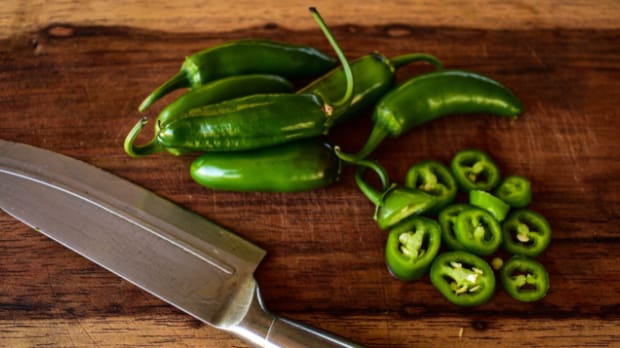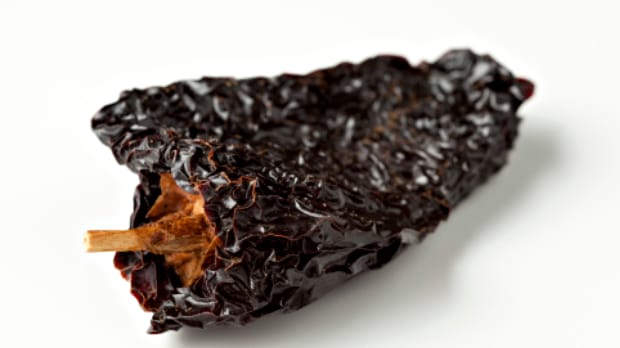What is a Jalapeño Pepper?
A jalapeno pepper is a smooth, dark green or scarlet red pepper that is about 2 inches long and 3/4 to 1 inch in diameter. It is named after Jalapa, the capital of Veracruz, Mexico. Although not as spicy as other chile peppers, jalapeños are highly favored for their flavor. One unique characteristic of the jalapeño pepper is that it is easily seeded, as the seeds and veins within the pepper are extra spicy. You can buy jalapeños both fresh and canned, and they can be included in a variety of meals and sauces. Often times, jalapeños are stuffed with cheese, fish or meat. Additionally, when jalapeño peppers are dried, they are called chipotles. If pickled, they are known as cscabeche. A jalapeño pepper is a diverse ingredient that is used in a multitude of dishes, ranging from fresh to dried forms.
- What is a Jalapeño Pepper?
- What are the Nutritional Benefits of Jalapeño Peppers?
- Types Available
- What are the Best Uses?
- How do You Store Jalapeño Peppers?
- How to Prepare a Jalapeno Pepper
- When is Jalapeño Pepper in Season?
- What to Serve Jalapeño Pepper With?
- What Traditional Cuisines Use Jalapeño Pepper?
- What are Some Recipes that Use Jalapeño Pepper?
- Key Takeaways
What are the Nutritional Benefits of Jalapeño Peppers?
Are you a fan of spicy foods? If so, jalapeño peppers may be a staple in your diet. Not only do they add heat and flavor to your meals, but they also have numerous nutritional benefits. One of the most notable benefits of jalapeños is their high vitamin C content. In fact, just one pepper contains more than 100% of your daily recommended intake of vitamin C. This antioxidant is crucial for maintaining a healthy immune system, promoting wound healing, and supporting healthy skin.

Jalapeños are also a good source of vitamin A, which is important for vision and skin health, as well as potassium, which aids in the regulation of blood pressure. Additionally, jalapeños are high in capsaicin, a compound that has been shown to have anti-inflammatory properties and may even aid in weight loss.
But the benefits don’t stop there. Jalapeños also contain fiber, which aids in digestion and promotes a feeling of fullness. Plus, they are low in calories and fat, making them a great addition to any diet. So next time you’re looking to add some spice to your meal, don’t hesitate to reach for a jalapeño pepper. Your body will thank you for it!
Types Available

Not only do these peppers add a kick to your favorite recipes, they are also packed with healthy nutrients. But did you know that there are different types of jalapeño peppers available? Here’s a rundown.
Traditional: This is the most common type of jalapeño pepper. It has a green skin and is harvested while still young. This type is easy to find at most grocery stores.
Red: If you’re looking for a sweeter jalapeño pepper, the red variety may be your best option. This type is left on the vine longer, allowing it to ripen and develop a deeper, reddish color.
Purple: For something a little unusual, try the purple jalapeño pepper. This type gets its unique hue from anthocyanins, which are natural pigments found in certain fruits and vegetables. No matter which type you choose, always remember to handle jalapeño peppers with care and wash your hands thoroughly after handling them. Enjoy your spicy creations and reap the health benefits of this versatile vegetable!
What are the Best Uses?
Not only are jalapeños easy to find at the grocery store, they’re also easy to use in your recipes. The delicious chili is well known for bringing the heat, but it has a great flavor too. This versatile vegetable can be used for many things, and you can adjust the heat level by removing the seeds.
An easy way to get started cooking with jalapeños is to chop them up to use in salsas, sauces, and dips. They add a spicy kick to guacamole, hummus, and even ketchup. For those who love a good burger, consider mixing diced jalapeños into meat patties for an extra level of flavor. For those who love a little heat with their breakfast, try adding diced jalapeños to scrambled eggs. This gives a unique and spicy twist to a classic meal.
If you’re feeling adventurous, you can also stuff jalapeños with cheese or meat for a delicious appetizer. These stuffed peppers can be baked or grilled and make a perfect addition to any party. And lastly, if you’re a fan of pickling, jalapeños are a great choice. They can be pickled alone or with other vegetables like carrots and cauliflower to make a spicy and tangy condiment. So, whether you love to cook or just enjoy a little extra heat in your meals, jalapeños can be a superstar ingredient.
How do You Store Jalapeño Peppers?
Do you have a bunch of jalapeños and are wondering how to keep them fresh? Whether you’re growing them at home or have picked up a batch from your local grocery store, the good news is that jalapeños are relatively easy to store. You can keep them in the fridge, just like other types of peppers. The key is to wrap them in a paper towel or put them in a plastic bag before placing them in the fridge. This helps to keep them dry, which can prevent mold and spoilage. They will keep for 1-2 weeks.
If you have a large batch of jalapeños, you can also consider freezing them. To do this, simply slice or chop the peppers and place them in a freezer-safe bag or container. Be sure to remove as much air as possible before sealing the bag/container and popping it in the freezer.
Another option is pickling your jalapeños. This involves soaking them in a vinegar-based brine with other flavorings, such as garlic or onion. Not only does pickling preserve your jalapeños, but it also adds a tangy taste that can be delicious on sandwiches or tacos. No matter how you choose to store your jalapeños, be sure to handle them with care. Jalapeño juice can be irritating to the skin, so wear gloves or thoroughly wash your hands after handling them. And of course, always wash your jalapeños before eating or cooking with them.
How to Prepare a Jalapeno Pepper
Hey there foodies, today we are going to talk about one of my favorite peppers – jalapeño! Jalapeño peppers are a key ingredient in Mexican dishes and add a spicy kick to your food. But, before you go ahead and add them to your recipe, you need to prepare them properly. Here’s a quick guide to help you out.
Look for peppers that are firm, smooth, and have no blemishes or soft spots. The size of the peppers doesn’t really matter, so choose the ones that suit your recipe. Rinse the jalapeño peppers under cold running water to remove dirt and any residue. Dry them off with a clean towel. Once the peppers are clean, they are ready to use in your recipe.
For most recipes, you’ll want to cut off the stem of the peppers and discard them. However, if you’re making an appetizer like jalapeño poppers, the stem can make a nice handle to hold while enjoying the finger food.
If you’re looking to spice up your meal, use the whole jalapeño. However, if you want the jalapeño flavor without the heat, you’ll want to remove the tip, ribs and seeds. One way to do this is to cut the pepper in half lengthwise. Then, use a spoon or a knife to gently remove the seeds and white membrane. Be careful not to touch the seeds and membranes. This is where the spicy capsaicin is concentrated, and it can cause a pepper burn. The easiest way to avoid this uncomfortable burning sensation is to wear gloves. Always make sure not to touch your eyes or face, and wash your hands throughly with soap and water after cutting the peppers.
When is Jalapeño Pepper in Season?
When it comes to finding the freshest and most flavorful Jalapeños, it’s important to know what season they are in season. Typically, jalapeños grow and thrive in the summer months, between June and September. That’s when they are at their peak in terms of quality and taste.
Of course, this can vary depending on where you live and where you source your produce from. If you’re lucky enough to have access to a local farmers market, you might be able to find fresh jalapeños as early as late spring, or as late as early fall.
No matter what time of year you choose to enjoy these delicious peppers, be sure to exercise caution when working with them in the kitchen. They can pack quite a punch of heat, and you’ll want to avoid accidentally touching your eyes or other sensitive areas after handling the peppers. So, to sum it up: if you want to delve into the world of fresh Jalapeños, summer is definitely the best time of year to do so. Happy cooking!
Improve Your Health With Seasonal Eating
What to Serve Jalapeño Pepper With?
- Guacamole
- Grilled Chicken
- Sour Cream
- Cheese
- Rice
- Beans
- Avocado
- Cornbread
- Salsa
- Fajitas
What Traditional Cuisines Use Jalapeño Pepper?
Jalapeño peppers are commonly used in Mexican, Tex-Mex, Southwestern, and Central American cuisines. They are also often used in Caribbean, Indian, Asian, and African dishes.
What are Some Recipes that Use Jalapeño Pepper?
- Jalapeño Poppers
- Creamy Jalapeño Dip
- Jalapeño Cheddar Cornbread
- Sizzling Jalapeño Chicken
- Quick 10 Minute Pickled Jalapeños
One of My Favorite Recipes is Pico de Gallo
Key Takeaways
- Wear gloves when cutting jalapeño peppers to prevent irritation of the skin.
- Remove the seeds and veins before cooking to reduce the heat of the pepper.
- Grill, roast, or sauté jalapeño peppers to bring out the flavor.
- Add jalapeño peppers to salads, sandwiches, salsas, and other dishes for a spicy flavor.
- Be mindful of how much jalapeño pepper you use; it can be quite spicy!
- Use sour cream, yogurt, or cheese to balance out the heat of the jalapeños.
- Store jalapeño peppers in the refrigerator for up to two weeks.
References: The Role of Spices in Health Promotion | Nutritional and Health Benefits of Chili Peppers (Capsicum spp.): A Review | Health Benefits of Jalapeño Pepper (Capsicum annuum L.): A Review | Jalapeno pepper consumption increases plasma carotenoid concentrations in humans | Health Benefits of Hot Pepper (Capsicum spp.): A Review |




